key MERCEDES-BENZ C-CLASS ESTATE 2007 Owners Manual
[x] Cancel search | Manufacturer: MERCEDES-BENZ, Model Year: 2007, Model line: C-CLASS ESTATE, Model: MERCEDES-BENZ C-CLASS ESTATE 2007Pages: 377, PDF Size: 6.19 MB
Page 321 of 377
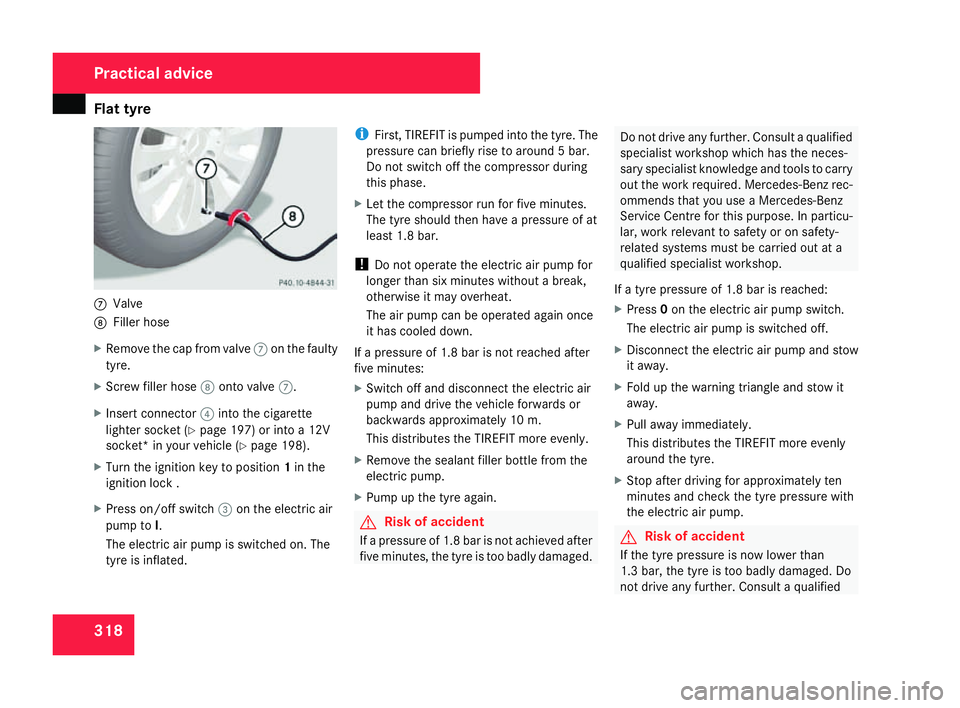
Flat tyre
3187
Valve
8 Filler hos e
X Remove the cap from valve 7on the faulty
tyre.
X Screw filler hose 8onto valve 7.
X Insert connector 4into the cigarett e
lighter socket (Y page 197) or into a 12V
socket* in your vehicle (Y page 198).
X Turn the ignition key to position 1in the
ignition lock .
X Press on/off switch 3on the electric air
pump to I.
The electric air pump is switched on. The
tyre is inflated. i
First, TIREFIT is pumped into the tyre. The
pressure can briefly rise to around 5 bar.
Do not switch off the compressor during
this phase.
X Let the compressor run for five minutes.
The tyre should then have a pressure of at
least 1.8 bar.
! Do not operate the electric air pump for
longer than six minutes without a break,
otherwise it may overheat.
The air pump can be operated again once
it has cooled down.
If a pressure of 1.8 bar is not reached after
five minutes:
X Switch off and disconnect the electric ai r
pump and drive the vehicle forwards or
backwards approximately 10 m.
This distributes the TIREFIT more evenly.
X Remove the sealant filler bottle from th e
electric pump.
X Pump up the tyre again. G
Risk of accident
If a pressure of 1.8 bar is not achieved afte r
five minutes, the tyre is too badly damaged. Do not drive any further. Consult a qualified
specialist workshop which has the neces-
sary specialist knowledge and tools to carry
out the work required. Mercedes-Benz rec-
ommends that you use a Mercedes-Benz
Service Centre for this purpose. In particu-
lar, work relevant to safety or on safety-
related systems must be carried out at
a
qualified specialist workshop.
If a tyre pressure of 1.8 bar is reached:
X Press 0on the electric air pump switch.
The electric air pump is switched off.
X Disconnect the electric air pump and stow
it away .
X Fold up the warning triangle and stow it
away .
X Pull away immediately.
This distributes the TIREFIT more evenly
around the tyre.
X Stop after driving for approximately ten
minutes and check the tyre pressure with
the electric air pump. G
Risk of accident
If the tyre pressure is now lower than
1.3 bar, the tyre is too badly damaged. Do
not drive any further. Consult a qualified Practical advice
204_AKB; 2; 3, en-G
B
mkalafa , 2007-06-26T23:11:51+02:00 - Seite 318
Page 328 of 377
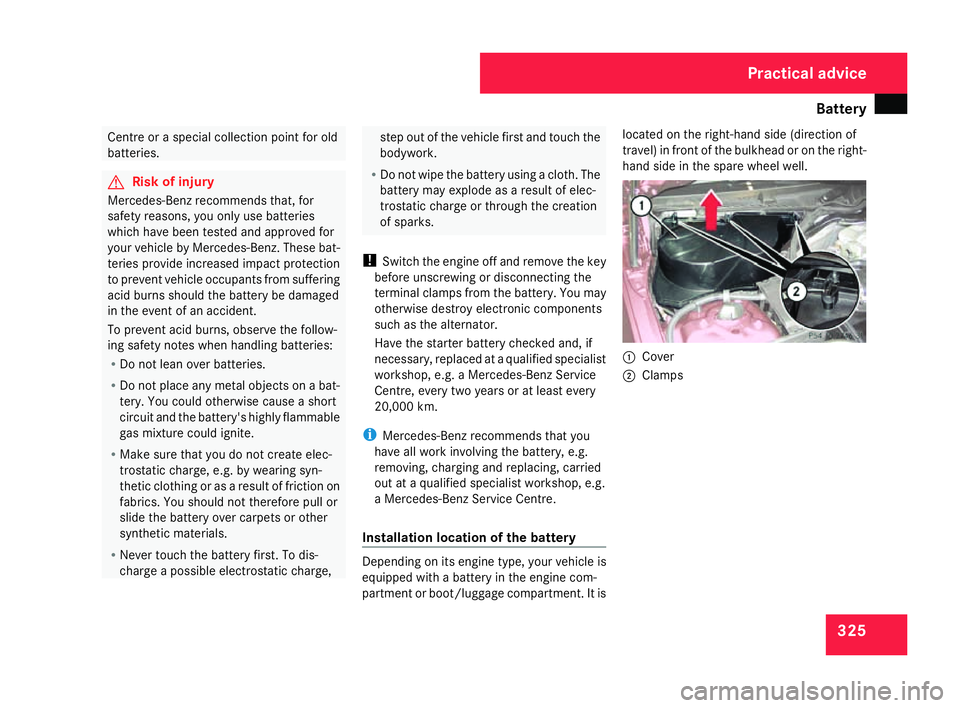
Battery
32
5 Centre or a special collection point for old
batteries . G
Risk of injury
Mercedes-Benz recommends that, for
safety reasons, you only use batteries
which have been tested and approved for
your vehicle by Mercedes-Benz. These bat-
teries provide increased impact protectio n
to prevent vehicle occupants from suffering
acid burns should the battery be damage d
in the event of an accident .
To prevent acid burns, observe the follow-
ing safety notes when handling batteries:
R Do not lean over batteries .
R Do not place any metal objects on a bat-
tery. You could otherwise cause a short
circuit and the battery's highly flammabl e
gas mixture could ignite.
R Make sure that you do not create elec-
trostatic charge, e.g. by wearing syn-
thetic clothing or as a result of friction on
fabrics. You should not therefore pull or
slide the battery over carpets or other
synthetic materials.
R Never touch the battery first. To dis-
charge a possible electrostatic charge, step out of the vehicle first and touch the
bodywork.
R Do not wipe the battery using a cloth. Th e
battery may explode as a result of elec-
trostatic charge or through the creation
of sparks .
! Switch the engine off and remove the key
before unscrewing or disconnecting the
terminal clamps from the battery. You may
otherwise destroy electronic components
such as the alternator.
Have the starter battery checked and, if
necessary, replaced at a qualified specialist
workshop, e.g. a Mercedes-Benz Service
Centre, every two years or at least every
20,000 km.
i Mercedes-Benz recommends that you
have all work involving the battery, e.g.
removing, charging and replacing, carried
out at a qualified specialist workshop, e.g.
a Mercedes-Benz Service Centre.
Installation location of the battery Depending on its engine type, your vehicle is
equipped with a battery in the engine com-
partment or boot/luggage compartment. It islocated on the right-hand side (direction of
travel) in front of the bulkhead or on the right-
hand side in the spare wheel well.
1
Cove r
2 Clamps Practical advice
204_AKB; 2; 3, en-GB
mkalafa,
2007-06-26T23:11:51+02:00 - Seite 32
5
Page 329 of 377
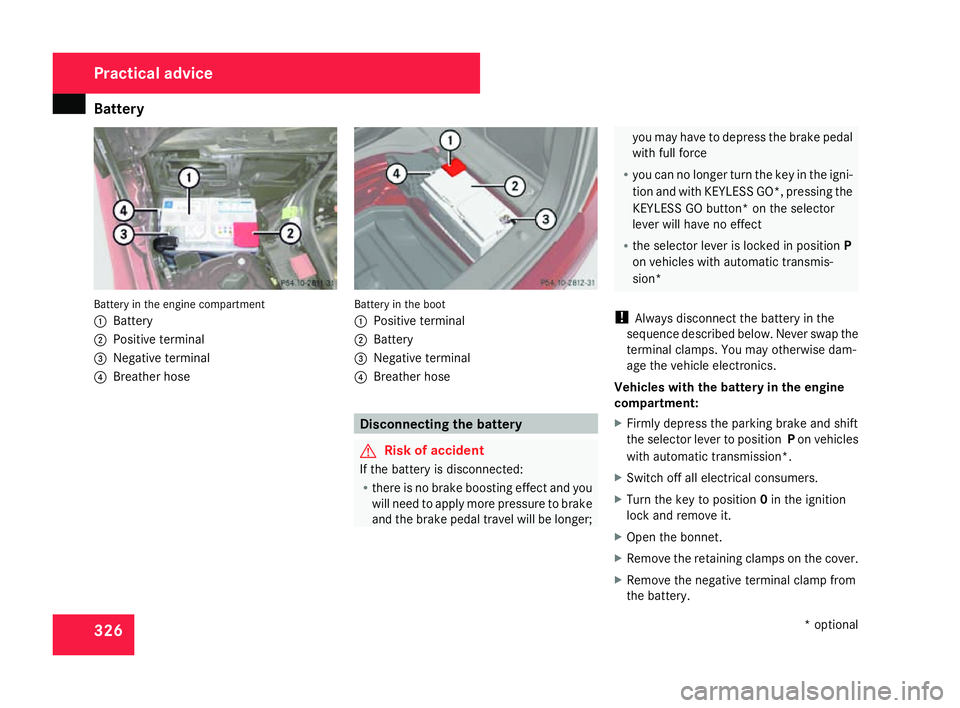
Battery
32
6 Battery in the engine compartment
1
Batter y
2 Positive terminal
3 Negative terminal
4 Breather hos e Battery in the boo
t
1 Positive terminal
2 Battery
3 Negative terminal
4 Breather hos e Disconnecting the batter
y G
Risk of accident
If the battery is disconnected:
R there is no brake boosting effect and yo u
will need to apply more pressure to brak e
and the brake pedal travel will be longer ; you may have to depress the brake peda
l
with full force
R you can no longer turn the key in the igni-
tion and with KEYLESS GO*, pressing th e
KEYLESS GO button* on the selector
lever will have no effect
R the selector lever is locked in position P
on vehicles with automatic transmis-
sion*
! Always disconnect the battery in the
sequence described below. Never swap the
terminal clamps. You may otherwise dam-
age the vehicle electronics.
Vehicles with the battery in the engine
compartment:
X Firmly depress the parking brake and shift
the selector lever to position Pon vehicles
with automatic transmission*.
X Switch off all electrical consumers .
X Turn the key to position 0in the ignition
lock and remove it.
X Open the bonnet.
X Remove the retaining clamps on the cover .
X Remove the negative terminal clamp from
the battery. Practical advice
* optional
204_AKB; 2; 3, en-GB
mkalafa,
2007-06-26T23:11:51+02:00 - Seite 32
6
Page 330 of 377
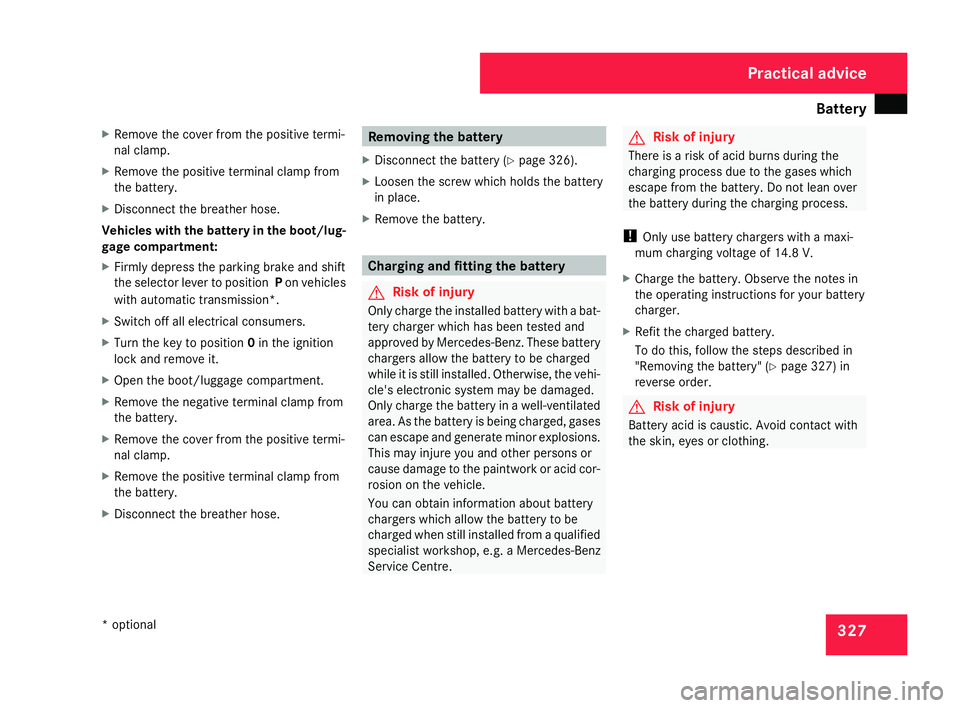
Battery
32
7
X
Remove the cover from the positive termi-
nal clamp.
X Remove the positive terminal clamp from
the battery.
X Disconnect the breather hose .
Vehicles with the battery in the boot/lug -
gage compartment :
X Firmly depress the parking brake and shift
the selector lever to position Pon vehicles
with automatic transmission*.
X Switch off all electrical consumers .
X Turn the key to position 0in the ignition
lock and remove it.
X Open the boot/luggage compartment.
X Remove the negative terminal clamp from
the battery.
X Remove the cover from the positive termi-
nal clamp.
X Remove the positive terminal clamp from
the battery.
X Disconnect the breather hose . Removing the battery
X Disconnect the battery (Y page 326).
X Loosen the screw which holds the battery
in place.
X Remove the battery. Charging and fitting the batter
y G
Risk of injury
Only charge the installed battery with a bat-
tery charger which has been tested and
approved by Mercedes-Benz. These battery
chargers allow the battery to be charge d
while it is still installed. Otherwise, the vehi -
cle's electronic system may be damaged.
Only charge the battery in a well-ventilate d
area. As the battery is being charged, gases
can escape and generate minor explosions.
This may injure you and other persons or
cause damage to the paintwork or acid cor-
rosion on the vehicle .
You can obtain information about battery
chargers which allow the battery to be
charged when still installed from a qualified
specialist workshop, e.g. a Mercedes-Ben z
Service Centre. G
Risk of injury
There is a risk of acid burns during the
charging process due to the gases which
escape from the battery. Do not lean ove r
the battery during the charging process.
! Only use battery chargers with a maxi-
mum charging voltage of 14.8 V.
X Charge the battery. Observe the notes in
the operating instructions for your battery
charger.
X Refit the charged battery.
To do this, follow the steps described in
"Removing the battery" (Y page 327) in
reverse order. G
Risk of injury
Battery acid is caustic. Avoid contact with
the skin, eyes or clothing . Practical advice
* optional
204_AKB; 2; 3, en-GB
mkalafa,
2007-06-26T23:11:51+02:00 - Seite 327
Page 334 of 377
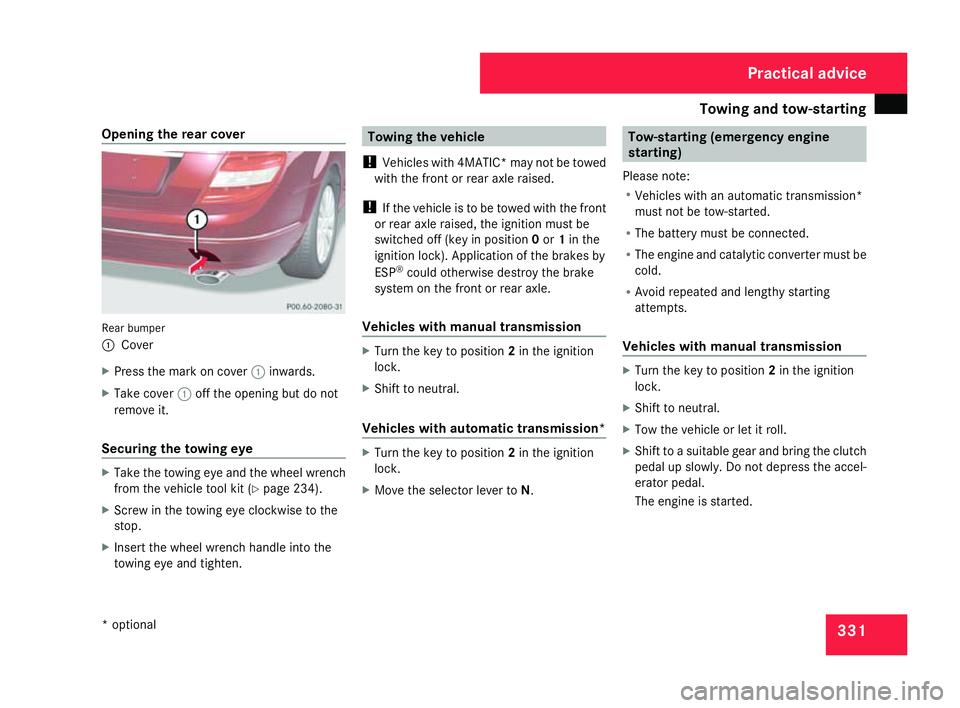
Towing and tow-startin
g 331
Opening the rear cover
Rear bumper
1
Cove r
X Press the mark on cover 1inwards.
X Take cover 1off the opening but do not
remove it.
Securing the towing eye X
Take the towing eye and the wheel wrench
from the vehicle tool kit (Y page 234).
X Screw in the towing eye clockwise to the
stop .
X Insert the wheel wrench handle into the
towing eye and tighten. Towing the vehicle
! Vehicles with 4MATIC* may not be towed
with the front or rear axle raised.
! If the vehicle is to be towed with the front
or rear axle raised, the ignition must be
switched off (key in position 0or 1in the
ignition lock). Application of the brakes by
ESP ®
could otherwise destroy the brake
system on the front or rear axle.
Vehicles with manual transmission X
Turn the key to position 2in the ignition
lock .
X Shift to neutral .
Vehicles with automatic transmission * X
Turn the key to position 2in the ignition
lock .
X Move the selector lever to N. Tow-starting (emergency engine
starting )
Please note:
R Vehicles with an automatic transmission*
must not be tow-started.
R The battery must be connected.
R The engine and catalytic converter must be
cold.
R Avoid repeated and lengthy starting
attempts .
Vehicles with manual transmission X
Turn the key to position 2in the ignition
lock .
X Shift to neutral .
X Tow the vehicle or let it roll.
X Shift to a suitable gear and bring the clutch
pedal up slowly. Do not depress the accel-
erator pedal.
The engine is started. Practical advice
* optiona l
204_AKB; 2; 3, en-GB
mkalafa,
2007-06-26T23:11:51+02:00 - Seite 331
Page 335 of 377
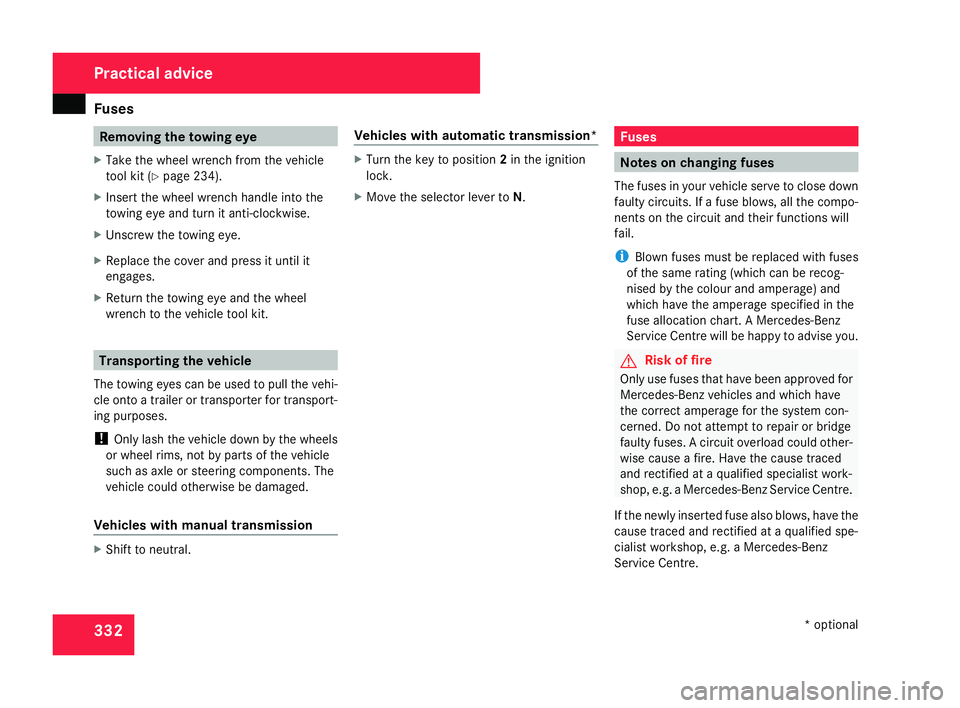
Fuse
s 332 Removing the towing eye
X Take the wheel wrench from the vehicle
tool kit (Y page 234).
X Insert the wheel wrench handle into the
towing eye and turn it anti-clockwise.
X Unscrew the towing eye.
X Replace the cover and press it until it
engages.
X Return the towing eye and the whee l
wrench to the vehicle tool kit .Transporting the vehicle
The towing eyes can be used to pull the vehi-
cle onto a trailer or transporter for transport-
ing purposes.
! Only lash the vehicle down by the wheels
or wheel rims, not by parts of the vehicl e
such as axle or steering components. The
vehicle could otherwise be damaged.
Vehicles with manual transmission X
Shift to neutral . Vehicles with automatic transmission
* X
Turn the key to position 2in the ignition
lock .
X Move the selector lever to N. Fuses
Notes on changing fuses
The fuses in your vehicle serve to close down
faulty circuits. If a fuse blows, all the compo -
nents on the circuit and their functions will
fail .
i Blown fuses must be replaced with fuses
of the same rating (which can be recog -
nised by the colour and amperage) and
which have the amperage specified in the
fuse allocation chart. A Mercedes-Benz
Service Centre will be happy to advise you. G
Risk of fire
Only use fuses that have been approved for
Mercedes-Benz vehicles and which have
the correct amperage for the system con-
cerned. Do not attempt to repair or bridge
faulty fuses. A circuit overload could other-
wise cause a fire. Have the cause trace d
and rectified at a qualified specialist work -
shop, e.g. a Mercedes-Benz Service Centre.
If the newly inserted fuse also blows, have the
cause traced and rectified at a qualified spe-
cialist workshop, e.g. a Mercedes-Benz
Service Centre. Practical advice
* optional
204_AKB; 2; 3, en-GB
mkalafa,
2007-06-26T23:11:51+02:00 - Seite 332
Page 336 of 377
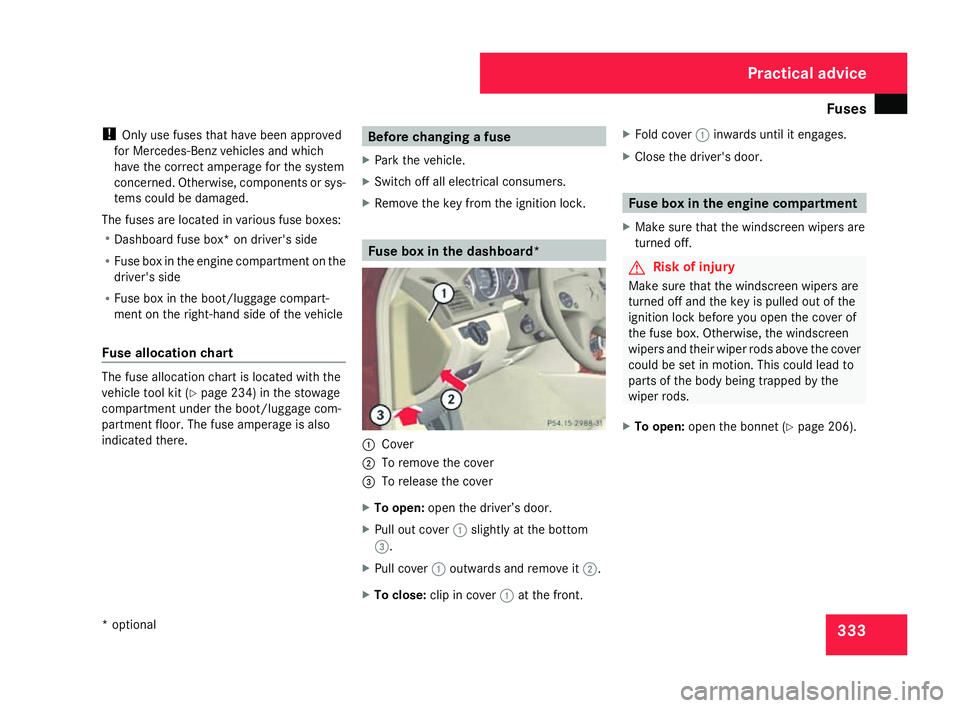
Fuse
s 333
!
Only use fuses that have been approved
for Mercedes-Benz vehicles and which
have the correct amperage for the system
concerned. Otherwise, components or sys-
tems could be damaged.
The fuses are located in various fuse boxes :
R Dashboard fuse box* on driver's side
R Fuse box in the engine compartment on the
driver's sid e
R Fuse box in the boot/luggage compart-
ment on the right-hand side of the vehicle
Fuse allocation chart The fuse allocation chart is located with the
vehicle tool kit (Y page 234) in the stowage
compartment under the boot/luggage com-
partment floor. The fuse amperage is also
indicated there. Before changing a fuse
X Park the vehicle.
X Switch off all electrical consumers .
X Remove the key from the ignition lock. Fuse box in the dashboard*
1
Cove r
2 To remove the cover
3 To release the cover
X To open: open the driver’s door.
X Pull out cover 1slightly at the bottom
3 .
X Pull cover 1outwards and remove it 2.
X To close: clip in cover 1at the front. X
Fold cover 1inwards until it engages.
X Close the driver's door . Fuse box in the engine compartment
X Make sure that the windscreen wipers are
turned off. G
Risk of injury
Make sure that the windscreen wipers are
turned off and the key is pulled out of the
ignition lock before you open the cover of
the fuse box. Otherwise, the windscreen
wipers and their wiper rods above the cove r
could be set in motion. This could lead to
parts of the body being trapped by the
wiper rods.
X To open: open the bonnet (Y page 206). Practical advice
* optional
204_AKB; 2; 3, en-GB
mkalafa,
2007-06-26T23:11:51+02:00 - Seite 333